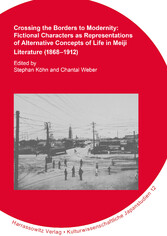Suchen und Finden
Service

Crossing the Borders to Modernity - Fictional Characters as Representations of Alternative Concepts of Life in Meiji Literature (1868-1912)
Stephan Köhn, Chantal Weber
Verlag Harrassowitz Verlag, 2022
ISBN 9783447392624 , 356 Seiten
Format PDF
Kopierschutz Wasserzeichen
Geräte
Mehr zum Inhalt

Crossing the Borders to Modernity - Fictional Characters as Representations of Alternative Concepts of Life in Meiji Literature (1868-1912)
The Meiji period (1868-1912) was a time of great political, economic, and social changes. Japan's new government transformed the former feudalistic state into a modern nation that would soon catch up with the Western world. However, this process of modernization also brought fundamental changes for the individual and affected virtually all aspects of everyday life. For those who questioned the benefits of Japan's rapid transformation, the Meiji period was a time in which they had to cross borders - borders between different cultures and epochs, and borders within society itself. Since the fractions and challenges caused by these processes of border-crossing are encapsulated in the fictional texts of that period, a thorough re-reading of Meiji literature can become a powerful means with which to reconstruct both hegemonic and alternative discourses of life during the Meiji period. This volume aims to analyze how a representative selection of Meiji authors positioned themselves in their writings, in terms of these fundamental changes. The contributors to this book seek to illustrate the numerous strategies of characterization and character constellation employed by these authors. The papers of this volume will not only deal with the fictional portrayal of the crossing of borders, but also with the fictional description of those who cross borders, those who are caught between tradition and modernity, between East and West and between different social groups. Crossing the borders to modernity offered both an opportunity and a challenge for literary characters as well as contemporary authors and readers; to find their place in Meiji society.
Shop

